Principle, Construction, Working Principle, Sensitivity, Solved Example Problems - Moving coil galvanometer | 12th Physics : Magnetism and Magnetic Effects of Electric Current
Chapter: 12th Physics : Magnetism and Magnetic Effects of Electric Current
Moving coil galvanometer
Moving coil galvanometer
Moving coil galvanometer
is a device which is used to indicate the flow of current in an electrical
circuit.
Principle
When a current carrying
loop is placed in a uniform magnetic field it experiences a torque.
Construction
A moving coil galvanometer
consists of a rectangular coil PQRS of insulated thin copper wire. The coil
contains a large number of turns wound over a light metallic frame. A
cylindrical soft-iron core is placed symmetrically inside the coil as shown in
Figure 3.66. The rectangular coil is suspended freely between two pole pieces
of a horse-shoe magnet.

The upper end of the rectangular coil is attached to one end of fine strip of phosphor bronze and the
lower end of the coil is connected to a hair spring which is also made up of
phosphor bronze. In a fine suspension strip W, a small plane mirror is attached
in order to measure the deflection of the coil with the help of lamp and scale
arrangement. The other end of the mirror is connected to a torsion head T. In order
to pass electric current through the galvanometer, the suspension strip W and
the spring S are connected to terminals.
Working
Consider a single turn of the rectangular coil PQRS whose length be l and breadth b. PQ = RS = l and QR = SP = b. Let I be the electric current flowing through the rectangular coil PQRS as shown in Figure 3.67.
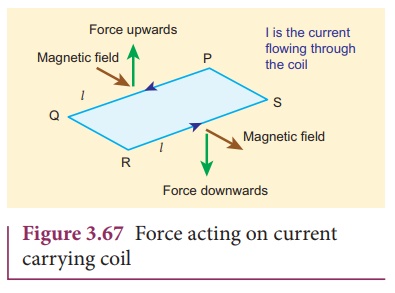
The horse-shoe magnet has hemi - spherical magnetic poles which produces a radial magnetic field.
Due to this radial field, the sides QR and SP are always parallel to to the
B-field (magnetic field) and experience no force. The sides PQ and RS are
always parallel to the B-field and experience force and due to this, torque is
produced.
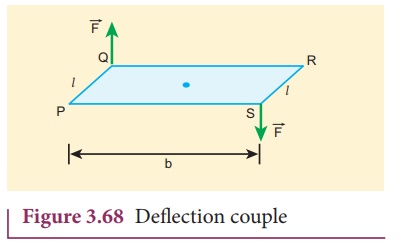
For single turn, the
deflection couple as shown in Figure 3.68 is
Ď„ = bF = bBIl= (lb) BI = ABI
since, area of the coil
A = lb
For coil with N turns,
we get

Due to this deflecting
torque, the coil gets twisted and restoring torque (also known as restoring
couple) is developed. Hence the magnitude of restoring couple is proportional
to the amount of twist θ (Refer Unit 10 of Std. XI Physics).Thus

where K is the
restoring couple per unit twist or torsional constant of the spring.
At equilibrium, the
deflection couple is equal to the restoring couple. Therefore by comparing
equation (3.69) and (3.70), we get

(or) I = G θ
where, G = K/NAB = is
called galvanometer constant or current reduction factor of the galvanometer.
Since, suspended moving
coil galvanometer is very sensitive, we have to handle with high care while
doing experiments. Most of the galvanometer we use are pointer type moving coil
galvanometer.
Figure of merit of a galvanometer
It is defined as the current which produces a deflection of one
scale division in the galvanometer.
Sensitivity of a galvanometer
The galvanometer is said
to be sensitive if it shows large scale deflection even though a small current
is passed through it or a small voltage is applied across it.
Current sensitivity: It
is defined as the deflection produced per unit current flowing through
it.

The current sensitivity
of a galvanometer can be increased
(a) by increasing
(1) the number of turns
N
(2) the magnetic
induction B
(3) the area of the coil
A
(b) by decreasing![]()
![]()
the couple per unit
twist of the suspension wire k. Phosphor - bronze wire is used as the
suspension wire because the couple per unit twist is very small.
Voltage sensitivity: It is
defined as the deflection produced per unit voltage applied across it.
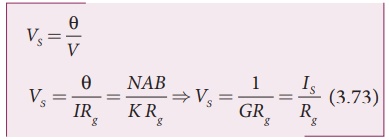
where Rg is
the resistance of galvanometer.
EXAMPLE 3.29
The coil of a moving
coil galvanometer has 5 turns and each turn has an effective area of 2 Ă— 10-2
m2. It is suspended in a magnetic field whose strength is 4 Ă— 10-2
Wb m-2. If the torsional constant K of the suspension fibre is 4 Ă—
10-9 N m deg-1.
(a) Find its current
sensitivity in degree per micro - ampere.
(b) Calculate the
voltage sensitivity of the galvanometer for it to have full scale deflection of
50 divisions for 25 mV.
(c) Compute the
resistance of the galvanometer.
Solution
The number of turns of
the coil is 5 turns
The area of each coil is
2 Ă— 10-2 m2
Strength of the magnetic
field is 4 Ă— 10-2 Wb m-2
Torsional constant is 4
Ă— 10-9 N m deg-1
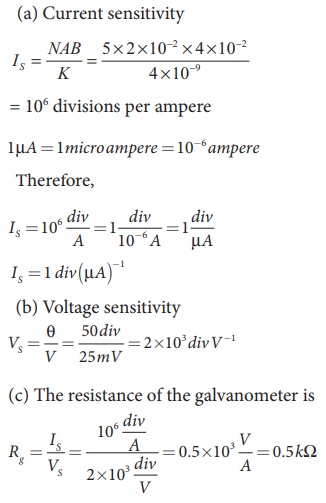
EXAMPLE 3.30
The resistance of a moving
coil galvanometer is made twice its original value in order to increase current
sensitivity by 50%. Will the voltage sensitivity change? If so, by how much?.
Solution
Yes, voltage sensitivity
will change.
Voltage sensitivity is Vs
= Is/R
When the resistance is
doubled, then new resistance is R ′ = 2R
Increase in current
sensitivity is
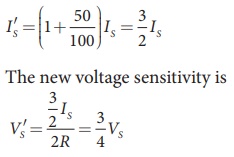
Hence the voltage
sensitivity decreases. The percentage decrease in voltage sensitivity is

Related Topics